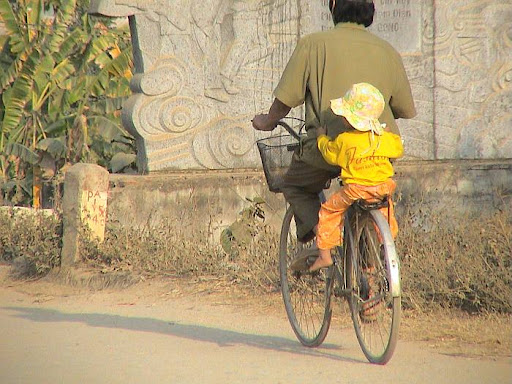Hidden treasures. We know that pirates have found a few, as have Spanish conquistadors, shipwreck salvage companies, and multinational oil corporations. But what about travelers?
It was late afternoon when I stumbled upon treasure in the Vietnamese town of Dien Bien Phu. I still remember how softly the sun's late afternoon light hit the dirt road as I sat by a dilapidated bridge, sipping a lukewarm Coke as I took in the scene. Passing in front of me were not cars, since the bridge was too small for cars--and also since there weren't many cars in this part of Vietnam. Instead there were children clinging to the backs of their bicycling parents, farmers on motorbikes hauling a cargo of live pigs or chickens, and students on their way home from school. The site was magical.
Dien Bien Phu doesn’t get many travelers—certainly not when compared to Hanoi, Halong Bay, or Sapa, the three most popular travel destinations in northern Vietnam.
It is a small provincial capital, nestled in a remote section of the country's northwest. And of those who do come to visit, you’ll be hard pressed to find any hanging out at the old bridge on the edge of town. Most will be at a museum or cemetery recalling the town's history.
In 1954 the world spotlight turned on Dien Bien Phu, which at the time was a sleepy crossroads near the Lao border that almost nobody had ever heard of. Since the previous century, the French had been governing Vietnam as well as neighboring Laos and Cambodia (together the three were known as Indochina). The problem with foreign rule, of course, is that locals don't often like it. When the Viet Minh, an independence movement challenging French rule, began to strengthen in the early 1950s, the French sought a way to crush it. Looking at a map, they decided to deploy thousands of troops to Dien Bien Phu. The goal: draw the Viet Minh out of the mountains and into the valley where, the French believed, their superior firepower would lead to a decisive victory.
The French, however, erred grievously. Unexpectedly, the Viet Minh found a way to haul heavy artillery up the rugged mountains. They then proceeded to pound the French until the French, unable to escape the valley, were forced to surrender. The French defeat stunned the world and was particularly noted in other colonies, where people now felt even more empowered to throw off their colonial masters. As for the French, Dien Bien Phu signaled the close of their colonial rule in Indochina.
I had come to Dien Bien Phu for its history. Sitting beside the bridge, just a quarter mile from the French command bunker, I thought of the dramatic events that once happened here. But what seared itself into my mind was not the rusting French tank or the abandoned bunkers, nor was it the Vietnamese cemetery half a mile away. It was that simple bridge. It was the men, women, and children--ordinary folks--who rode across it on their bicycles and motorbikes. It was the laughter and the grace, the sweat and the neighborliness. It was the acute realization that I, a traveler from thousands of miles away, had the privilege of sitting here with a warm Coke, watching the people who called this place home as late afternoon light fell to Earth.
In Dien Bien Phu I had stumbled upon hidden treasure. Some would call it nothing but an aging bridge, but for me it was much more.



Joel Carillet, chief editor of Wandering Educators, is a freelance writer and photographer based in Tennessee. His most recent project is 30 Reasons to Travel: Photographs and Reflections from Southeast Asia, due for release in June.
